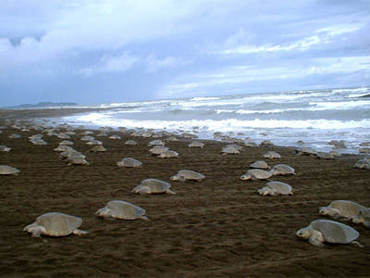When a loggerhead turtle crawls off the Florida beach for the first time, it’s only a few inches long, and momma doesn’t stick around to guide it out to sea. Yet after a decade or more looping around the Atlantic Ocean, all the way to Africa or Europe and back, the turtle returns to the same nesting area where it hatched.
 Many sea turtles use magnetic navigation to return to nesting grounds. Credit: National Oceanic and Atmospheric Administration/ David Shale
Many sea turtles use magnetic navigation to return to nesting grounds. Credit: National Oceanic and Atmospheric Administration/ David ShaleThe loggerhead makes that loop with the help of a magnetic “map” that may be imprinted when it’s hatched. It uses variations in Earth’s magnetic field to navigate across thousands of miles of ocean — and it’s not alone. Other species of turtles use magnetic navigation as well. So do salmon and lobsters. And there’s some evidence that whales and dolphins may as well.
Researchers have tested many of these creatures in the lab or at sea. In one example, they put lobsters inside sealed containers, drove them around in loops, and covered their eyestalks, then put different groups at different spots on the ocean floor. The lobsters all headed back toward their home grounds. They also headed toward home when they were put in test chambers that simulated the magnetic fields at different locations.
But researchers aren’t sure how these creatures use the magnetic field to navigate. Some of them have tiny crystals in their bodies that may align with the magnetic field. Others are sensitive to tiny changes in electric fields, which may be influenced by the magnetic field.
However they do it, these creatures are attracted back to their home grounds — by the giant magnet created by Earth itself.

